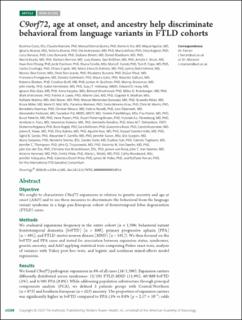| dc.contributor.author | Costa, Beatrice | |
| dc.contributor.author | Manzoni, Claudia | |
| dc.contributor.author | Bernal-Quiros, Manual | |
| dc.contributor.author | Kia, Demis A. | |
| dc.contributor.author | Aguilar, Miquel | |
| dc.contributor.author | Alvarez, Ignacio | |
| dc.contributor.author | Alvarez, Victoria | |
| dc.contributor.author | Andreassen, Ole Andreas | |
| dc.contributor.author | Anfossi, Maria | |
| dc.contributor.author | Bagnoli, Silvia | |
| dc.contributor.author | Benussi, Luisa | |
| dc.contributor.author | Bernardi, Livia | |
| dc.contributor.author | Binetti, Giuliano | |
| dc.contributor.author | Blackburn, Daniel | |
| dc.contributor.author | Boada, Mercè | |
| dc.contributor.author | Borroni, Barbara | |
| dc.contributor.author | Bowns, Lucy | |
| dc.contributor.author | Bråthen, Geir | |
| dc.contributor.author | Bruni, Amalia C | |
| dc.contributor.author | Chiang, Huei-Hsin | |
| dc.contributor.author | Clarimon, Jordi | |
| dc.contributor.author | Colville, Shuna | |
| dc.contributor.author | Conidi, Maria E | |
| dc.contributor.author | Cope, Tom E | |
| dc.contributor.author | Cruchaga, Carlos | |
| dc.contributor.author | Cupidi, Chiara | |
| dc.contributor.author | Di Battista, Maria Elena | |
| dc.contributor.author | Diehl-Schmid, Janine | |
| dc.contributor.author | Diez-Fairen, Monica | |
| dc.contributor.author | Dols-Icardo, Oriol | |
| dc.contributor.author | Durante, Elisabetta | |
| dc.contributor.author | Flisar, Dusan | |
| dc.contributor.author | Frangipane, Francesca | |
| dc.contributor.author | Galimberti, Daniela | |
| dc.contributor.author | Gallo, Maura | |
| dc.contributor.author | Gallucci, Mauricio | |
| dc.contributor.author | Ghidoni, Roberta | |
| dc.contributor.author | Graff, Caroline | |
| dc.contributor.author | Grafman, Jordan H | |
| dc.contributor.author | Grossman, Murray | |
| dc.contributor.author | Hardy, John | |
| dc.contributor.author | Hernández, Isabel | |
| dc.contributor.author | Holloway, Guy J T | |
| dc.contributor.author | Huey, Edward D | |
| dc.contributor.author | Illán-Gala, Ignacio | |
| dc.contributor.author | Karydas, Anna | |
| dc.contributor.author | Khoshnood, Behzad | |
| dc.contributor.author | Kramberger, Milica G. | |
| dc.contributor.author | Kristiansen, Mark K | |
| dc.contributor.author | Sando, Sigrid Botne | |
| dc.date.accessioned | 2021-02-17T15:10:58Z | |
| dc.date.available | 2021-02-17T15:10:58Z | |
| dc.date.created | 2021-01-14T12:23:52Z | |
| dc.date.issued | 2020 | |
| dc.identifier.citation | Neurology. 2020, 95 (24), e3288-e3302. | en_US |
| dc.identifier.issn | 0028-3878 | |
| dc.identifier.uri | https://hdl.handle.net/11250/2728759 | |
| dc.description.abstract | Objective: We sought to characterize C9orf72 expansions in relation to genetic ancestry and age at onset (AAO) and to use these measures to discriminate the behavioral from the language variant syndrome in a large pan-European cohort of frontotemporal lobar degeneration (FTLD) cases. Methods: We evaluated expansions frequency in the entire cohort (n = 1,396; behavioral variant frontotemporal dementia [bvFTD] [n = 800], primary progressive aphasia [PPA] [n = 495], and FTLD-motor neuron disease [MND] [n = 101]). We then focused on the bvFTD and PPA cases and tested for association between expansion status, syndromes, genetic ancestry, and AAO applying statistical tests comprising Fisher exact tests, analysis of variance with Tukey post hoc tests, and logistic and nonlinear mixed-effects model regressions. Results: We found C9orf72 pathogenic expansions in 4% of all cases (56/1,396). Expansion carriers differently distributed across syndromes: 12/101 FTLD-MND (11.9%), 40/800 bvFTD (5%), and 4/495 PPA (0.8%). While addressing population substructure through principal components analysis (PCA), we defined 2 patients groups with Central/Northern (n = 873) and Southern European (n = 523) ancestry. The proportion of expansion carriers was significantly higher in bvFTD compared to PPA (5% vs 0.8% [p = 2.17 × 10-5; odds ratio (OR) 6.4; confidence interval (CI) 2.31-24.99]), as well as in individuals with Central/Northern European compared to Southern European ancestry (4.4% vs 1.8% [p = 1.1 × 10-2; OR 2.5; CI 1.17-5.99]). Pathogenic expansions and Central/Northern European ancestry independently and inversely correlated with AAO. Our prediction model (based on expansions status, genetic ancestry, and AAO) predicted a diagnosis of bvFTD with 64% accuracy. Conclusions: Our results indicate correlation between pathogenic C9orf72 expansions, AAO, PCA-based Central/Northern European ancestry, and a diagnosis of bvFTD, implying complex genetic risk architectures differently underpinning the behavioral and language variant syndromes. | en_US |
| dc.language.iso | eng | en_US |
| dc.publisher | Lippincott, Williams & Wilkins, American Academy of Neurology (AAN) | en_US |
| dc.rights | Navngivelse 4.0 Internasjonal | * |
| dc.rights.uri | http://creativecommons.org/licenses/by/4.0/deed.no | * |
| dc.title | C9orf72, age at onset, and ancestry help discriminate behavioral from language variants in FTLD cohorts | en_US |
| dc.type | Peer reviewed | en_US |
| dc.type | Journal article | en_US |
| dc.description.version | publishedVersion | en_US |
| dc.source.pagenumber | e3288-e3302 | en_US |
| dc.source.volume | 95 | en_US |
| dc.source.journal | Neurology | en_US |
| dc.source.issue | 24 | en_US |
| dc.identifier.doi | 10.1212/WNL.0000000000010914 | |
| dc.identifier.cristin | 1871282 | |
| dc.description.localcode | Copyright © 2020 The Author(s). Published by Wolters Kluwer Health, Inc. on behalf of the American Academy of Neurology. This is an open access article distributed under the terms of the Creative Commons Attribution License 4.0 (CC BY), which permits unrestricted use, distribution, and reproduction in any medium, provided the original work is properly cited. | en_US |
| cristin.ispublished | true | |
| cristin.fulltext | original | |
| cristin.qualitycode | 2 | |

